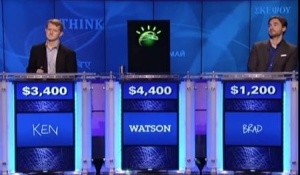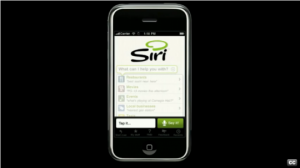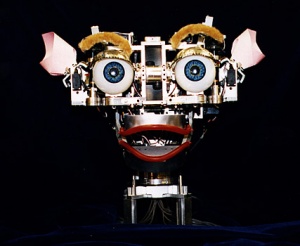Artificial Intelligence and Technology
Artificial intelligence (AI) is the theory and development of computer systems able to perform tasks that normally require human intelligence, such as visual perception, speech recognition, decision-making, and translation between languages. Artificial intelligence can have a huge impact on the way humans interact with each other and with technology. It was once thought that the human mind was unable to be replicated, but recent technological advances have allowed computers to simulate human intelligence. This allows computers to recognize contextual factors and other aspects of human thought that computers were previously unable to understand. Artificial intelligence has the potential to impact our everyday lives. (Back to index)
History
Although the thought of artificial intelligence dates back to the invention of the modern computer, the concept did not really expand until the middle of the 20th century. In 1956, John McCarthy coined the term “artificial intelligence” during the first discussion about the topic at the Dartmouth Conference. In 1962, IBM finished the development of the first program able to play checkers, which eventually defeated the checkers world champion. One year later, in 1963, Thomas Evans demonstrated that computers are able to solve the same types of questions that humans typically solve on IQ exams. The year after that, this type of problem solving was expanded further when Danny Bobrow demonstrated that computers are able to understand human speech sufficiently enough to solve word problems.
The 1970s led to the development of natural language processing, or the ability for computers to interpret human speech. The 1980s led to some more developments in the field, but it wasn’t until the 1990s when major advances were made. Advances in the fields of machine learning, intelligent tutoring, case-based reasoning, uncertain reasoning, natural language processing, as well as language translation all contributed to the further development of AI. In the 2000s, advances in robots were accomplished and put to use towards scientific investigation, car racing, and children’s toys. Today, natural language processing and dictation begin to play a role in the advancement of mobile technology.
Problems
The main question to be asked is, “Can computers act and think like humans?” Are they able to reason deductively, solve complex problems, answer questions, learn new material, or process human speech?
Deductive Reasoning
While humans are able to deductively reason almost subconsciously by using their intuition, computers could only do so for a while using step-by-step algorithms. This was a good solution until problems became too complex. A lot of research is currently being devoted to making machines reason faster using more complex algorithms.
Learning
Learning is intuitive to humans, but not to computers. Machine learning dates back to the first artificial intelligence conference, in 1956. It involves the ability to recognize patterns, adapt to them, and use that knowledge to help solve future problems. This can be very helpful in processing natural language.
Natural Language Processing
Natural language processing is the ability for computers to listen to, interpret, and understand human speech. This has applications in many fields, including virtual personal assistants, information retrieval, and data mining.
Social Intelligence
Intelligent agents must be able to understand the emotions and motives of others in order to predict their actions. [1] They must also be able to display emotions themselves. At the most basic level, intelligent agents must appear polite and sensitive to human interaction.
Planning
Humans can visualize the future. They have a representation of the current state of their surroundings and are able to make predictions about how their actions will affect their surroundings. Intelligent agents must possess similar abilities in planning and prediction, in order to make decisions that maximize the value of the available choices.
Examples


IBM’s Watson
Recently, IBM developed a computer they named “Watson,” which is a question and answering machine that defeated the world’s best Jeopardy player. The computer received the clues in text format, and was able to formulate and verbalize an answer. Not only was it able to solve questions with direct clues, it was also able to decipher aspects of language unique to humans, such as sarcasm, puns, and metaphors.
Siri
Siri is a company that was bought by Apple in April of 2010. Then, it was an application for mobile devices that acted as a virtual personal assistant, able to answer questions, schedule meetings, get directions, as well as a variety of other tasks. In addition to Apple’s recent announcement of the iPhone 4S, they have also announced that Siri will act as a personal assistant within the new iPhone. It enables the user to use his or her voice to send text messages, schedule meetings, make phone calls, and set reminders. Not only does understand what you say, it is also able to interpret the meaning behind what you are saying. For example, you could say “Tell my brother that I am running 20 minutes late.” Siri will understand this and send a text message to your brother stating you will be 20 minutes late. You could also ask Siri, “Am I going to need a raincoat today,” and it will respond by pulling up the latest weather forecast. It is also able to dictate human speech, so you could send a text message simply by speaking it. This could change the way humans interact with their mobile devices, and has the potential to create a whole new field of computing: virtual personal assistants.[2]
Recently controversy over the programming of Siri in regards to abortion has come to light. Pro-choice advocates alleged that Google programmed Siri to be pro-life. This is because when one asked Siri to search for local abortion clinics, Siri would not display any Planned Parenthood that were known to be in the area. [3] These groups also alleged that even when names of specific abortion clinics were inputted, Siri would be unable to find them. Google responded by releasing a statement saying that it was a technical glitch and would be fixed when the final version of Siri is released. The cause of the glitch seemed to come from where Siri would retrieve information from to search for specific places. Google reported that Siri gets information from Yelp, where Planned Parenthood is not categorized as an abortion clinic. Also Siri uses Wolfram Alpha as its main query site, which presents answers differently than other search engines such as Google and Yahoo. This was another possible reason that was given for the glitch.
AI in Bioware Games
Main Article: BioWare
BioWare is a video game developer that implements many sci-fi and fantasy themes in their game environments - including the use of A.I. as a controllable character and a benevolent entity.
Ethics of Artificial Intelligence
One question that could be asked is, “If computers are able to think like humans, understand humans, and react to humans, do they deserve the same rights as humans?” Computers are now able to make ethical decisions, whether intended or not, and these decisions affect the objects that interact with them and for that reason is why these artificial Intelligence agents are being considered to be held accountable for these actions. While some might think that this is a silly question, it is actually a pertinent one that must be taken into account when designing artificial beings. This concept is part of the main idea of Luciano Floridi's ethical model of the Infosphere, where all information entities have the power to do good and evil in the world.
Another issue has to do with privacy. If computers are able understand human speech and thought, then with the right program computers could interpret phone conversations, text messages, emails, as well as other documents. It would be able to identify which people are having a conversation, as well as the details of that conversation. This could enable the user to do a wide variety of things with this information, ranging from identity theft to insider trading.
Another factor that must be taken into account is that artificial intelligence has the potential to replace humans in multiple respects. AI is already implemented in some phone operating systems, acting as customer service representatives to help customers troubleshoot. AI could replace other positions that humans currently occupy, such as bank tellers or therapists. Some of the positions that AI has the potential to fill require human feelings of empathy. If such positions are filled with computers they will lose this sense of empathy, which could have negative repercussions on the people using them.
Tools
AI has been an ongoing field of research for years. During these years of advancement, AI has developed many tools to solve some of the most difficult problems in computer science.
Search and optimization
Simple search algorithms are not sufficient for most real world problems. As time goes on, more and more information is made available, and the search space quickly grows infinitely. This means that either the search will be too slow or it will never finish. "Heuristics" often times, seem to be the solution for this problems. Heuristics is the term used to eliminate choices that are unlikely to lead to the goal. Heuristics supply the program with a "best guess" for the path on which the solution lies. [4]
In the 1990s, a new kind of search surfaced. This was based on the mathematical theory of optimization. This makes it possible to begin the search with some form of a guess and then refine the guess incrementally until no more refinements can be made. These algorithms begin the search at some random point, and then jumps around until it reaches the end of the search.
Logic
Logic is used for knowledge representation and problem solving, but can be applied in other areas as well. For example, the satplan algorithm uses logic for planning, [5] and inductive logic programming is a method for learning [6]
Several forms of logic are used in AI research. Propositional logic is the logic of statements which can be true or false. First-order logic also allows the use of quantifiers and predicates, and can express facts about objects, their properties, and their relations with each other. [7]
Fuzzy logic is a version of first-order logic which allows the truth of a statement to be represented as a value between 0 and 1, rather than simply True (1) or False (0). Fuzzy systems can be used for uncertain reasoning and have been widely used in modern industrial and consumer product control systems. [8]
Subjective logic models uncertainty in a different and more explicit manner than fuzzy-logic: a given binomial opinion satisfies belief + disbelief + uncertainty = 1 within a Beta distribution. By this method, ignorance can be distinguished from probabilistic statements that an agent makes with high confidence. [9]
Probabilistic methods for uncertain reasoning
Many problems in AI require the agent to operate with incomplete information. Researchers have devised a number of powerful tools to solve these problems using methods from probability theory and economics. [10]
Bayesian networks are a tools that can be used for a large number of problems. They can be used for reasoning, learning, and perception. [11]
Classifiers and statistical learning methods
AI applications can be divided into two types: classifiers and controllers. A Classifier uses pattern matching to determine the closest match. Classifiers can be tuned to examples or previous patterns which makes them especially useful for use in AI. A controller determines the action to be taken once it is classified.
Neural Networks
Neural networks began in the decade before AI research was founded. [12] Many researchers developed this algorithm.
Tha main categories of networks are neural networks.
They are comprised of interconnecting artificial neurons. They may be used to either gain an understanding of biological neural networks or solving AI problems. [13]- ↑ http://en.wikipedia.org/wiki/Affective_computing
- ↑ Learn more about siri. (2011). Retrieved from http://www.apple.com/iphone/features/siri-faq.html
- ↑ http://www.computerworld.com/s/article/9222280/Apple_s_Siri_balks_at_abortion_queries_pro_choice_advocates_charge
- ↑ [10]
- ↑ [11]
- ↑ [12]
- ↑ [13]
- ↑ [ Fuzzy logic,[115] is a version of first-order logic which allows the truth of a statement to be represented as a value between 0 and 1, rather than simply True (1) or False (0). Fuzzy systems can be used for uncertain reasoning and have been widely used in modern industrial and consumer product control systems.]
- ↑ [14]
- ↑ [15]
- ↑ [16]
- ↑ [17]
- ↑ [18] </ref/>
See Also
References
- ↑ http://en.wikipedia.org/wiki/Affective_computing
- ↑ Learn more about siri. (2011). Retrieved from http://www.apple.com/iphone/features/siri-faq.html
- ↑ http://www.computerworld.com/s/article/9222280/Apple_s_Siri_balks_at_abortion_queries_pro_choice_advocates_charge
- ↑ [1]
- ↑ [2]
- ↑ [3]
- ↑ [4]
- ↑ [ Fuzzy logic,[115] is a version of first-order logic which allows the truth of a statement to be represented as a value between 0 and 1, rather than simply True (1) or False (0). Fuzzy systems can be used for uncertain reasoning and have been widely used in modern industrial and consumer product control systems.]
- ↑ [5]
- ↑ [6]
- ↑ [7]
- ↑ [8]
- ↑ [9] </ref/>
See Also
References
<references/>
